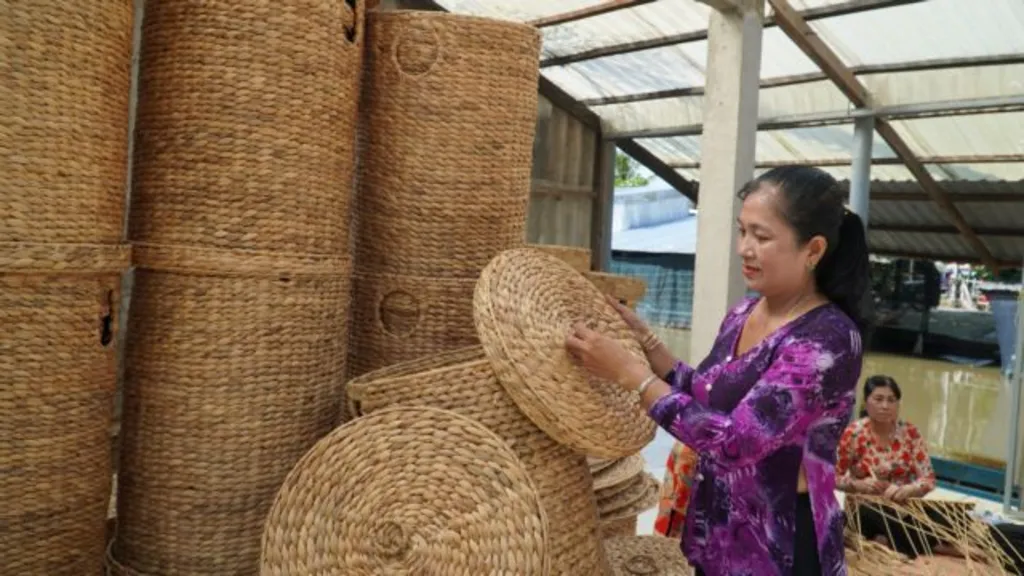 Society
Society

 |
| Farmers have started harvesting the winter-spring rice in Kiên Giang Province’s Tân Hiệp District. They earn an average income of VNĐ35-40 million (US$1,400-1,600) per hectare from the crop. – VNA/VNS Photo Lê Huy Hải |
KIÊN GIANG – Kiên Giang Province is restructuring agriculture to increase productivity together with developing farming co-operatives.
The Cửu Long (Mekong) Delta province also aims to develop value chains for agricultural products and improve their quality.
It aims to establish 10 new agricultural co-operatives linked with consumers this year.
It has earmarked VNĐ15 billion (US$600,000) to invest in infrastructure for co-operatives operating in agriculture, forestry and fisheries this year.
It will implement central and local policies and plans to renovate, develop and improve the efficiency of the collective economy, according to Lê Quốc Anh, deputy chairman of the province People’s Committee.
It will strengthen consulting and advocacy activities for the establishment of co-operatives, and support the development of linkages between various stakeholders in producing and consuming agricultural produce.
The province Co-operatives Alliance, in co-operation with relevant agencies and ministries, will provide training to managers of co-operatives.
It will carry out trade promotion activities and help co-operatives participate in trade fairs organised by the Việt Nam Co-operatives Alliance.
It will collaborate with the province Departments of Industry and Trade and Agriculture and Rural Development and Farmers Association to establish linkages between agricultural companies and co-operatives.
It will help agricultural co-operatives register product quality, trademarks and product traceability.
The province has 453 agricultural co-operatives, which account for 87 per cent of all co-operatives, with 33,000 members who have a total of 64,200ha.
Lê Hữu Toàn, director of the Department of Agriculture and Rural Development, said agricultural co-operatives had helped manage natural resources and effectively cope with climate change.
Their revenues and profits were not high but they had helped their members adopt advanced farming techniques and increase their incomes by VNĐ 900,000-2.2 million ($36-80) per hectare, he said.
The Kênh 7B Agricultural Co-operative in Tân Hiệp District’s Thạnh Đông A Commune is one of the province’s effective co-operatives with good linkages for selling its output.
Established in 2001, it has 294 members growing 526ha of rice. It provides irrigation for their rice fields and sells them inputs.
According to Võ Minh Chiến, its director, the co-operative also has 50ha to grow rice seeds, which too it sells to its members.
The members grow rice to Vietnamese good agricultural practices (VietGAP) standards and have guaranteed buyers.
 |
| Handicraft products made from dried water hyacinth stems by Thuận Phát Handicraft Product Co-operative in Kiên Giang Province’s Gò Quao District. The co-operative provides regular employment for nearly 400 workers. – VNA/VNS Photo Văn Sĩ |
Rice production
Kiên Giang, the country’s largest rice producing province, aims to grow 4.4 million tonnes of the grain this year, with high-quality rice accounting for 90 per cent of it, according to the agriculture department.
It is focusing on creating more large-scale rice fields by pooling individual farmers’ holdings and growing the grain to VietGAP, GlobalGAP and other international quality standards.
It has 1,334 large-scale rice fields with a total area of 167,225ha, including 55,166ha that have high-quality certificates to export to the EU, the US, Japan, and other wealthy markets.
The province is participating in a Ministry of Agriculture and Rural Development programme to cultivate one million hectares of high-quality, low-emissions rice in alignment with the country’s green growth goals in the Mekong Delta.
The area under rice under the programme will reach 100,000ha in 2025 and double that by 2030.
This year it is 60,000ha with 102 co-operatives participating in the programme.
In the ongoing winter-spring crop, farmers have planted more than 280,200ha of rice and are expected to get an average yield of 7.5 tonnes per hectare.
The province encourages farmers to switch to other crops and raise animals on unproductive rice fields to earn higher incomes.
Toàn said: “We will continue to convert unproductive mono rice growing areas into shrimp-rice farms to increase value and cope with climate change safely and effectively.”
The development of shrimp-rice farming in which rice is grown in the rainy season and shrimp is bred in the dry season on the same fields has proven effective in coastal areas, where fields are affected by saltwater intrusion during the latter.
The province has more than 100,000ha of shrimp-rice areas, including 2,000ha with Vietnamese or international quality certification such as GlobalGAP, Global Aquaculture Stewardship Council and Best Aquaculture Practices, according to the department. – VNS




